
summary
API3 is an innovative first -party prophet project that focuses on enabling data providers to run its own prophecy machine, so as to ensure that the first party passes the data directly to the blockchain application without the need for intermediaries.Trust problems.The API3 provider to ensure the quality standards of the data provider will be replaced by the standard data provider that fails to meet the standard, which will reduce the user’s dependence on trust while ensuring the integrity of the data.
By using AIRNODE technology to deploy the first -party prophecy machine and decentralized API (DAPI), API3 promotes a more direct, secure and efficient connection between the data provider and the blockchain network. This mechanism alleviates the traditional third -party prophet machinePossible problems ensure higher security, transparency and higher efficiency, and reduce data transmission costs and potential risk points.
The mechanism of the combination of OEV Network and ZK-Rollup has brought greater competitiveness to API3, and also brought major progress to DAPP and prophecy machine tracks.This solution has captured MEV and nurtured value to the agreement ecology to release new value flow to stakeholders, promoting a more balanced and financially sustainable ecosystem.
API3 has a well -designed, unique and powerful token economic model.Its tokens are fully empowerment, and the burning mechanism and pledge reward lock for one year against inflation, and encourage pledge through a dynamic APR.More importantly, the design of its economic model incorporates the operation and risk factors of the agreement itself, bringing a self -regulation mechanism of negative feedback cycle, so that the stakeholders and governors can quickly achieveConflict, and then to improve the stability of the protocol by suppressing excessive risks, and ultimately make the development of the agreement form a positive cycle and benefit many parties for a long time.
With the innovative first -formulating machine method and high attention to data reliability and security, combined with the complete decentralized governance model of DAO, and a wider range of application scope in data provision, the future of API3 will not be limited toAs an intermediate component, it provides a prediction machine feeding service, but it may become an infrastructure for the development of ecological and diverse DAPP development on the chain. It provides more possibility of the development of chain development in our real life.While setting up new standards for the prophet track, it continues to promote the innovation of ecosystems.
>
In the continuous development of Web3.0 ecosystems, decentralized applications (DAPP) are experiencing rapid growth, and its increasing value highlights their potential, and also expands the demand for real world data integration, so that soThe decentralized prophet track has become one of the most important part of the ecosystem on the chain.
However, a major challenge still exists: how to seamless and securely integrate the linked data into the blockchain ecosystem.Against this background, API3 appears as a solution to this challenge, aiming to completely change the data interface between the under -chain and the environment on the chain.
>
>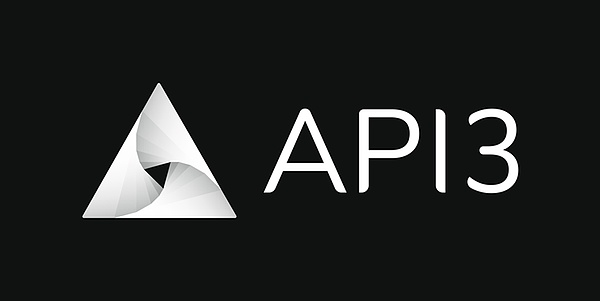
API3 was launched in December 2020. It is a pioneering innovative first -party prediction machine project. The goal is to enable most of the API customized APIs for the decentralized application to enter the decentralized world of web3.0. At the same timeIt will bring a significant burden on the developers of API providers or DAPP projects.
Different from the traditional third -party prophecy machine network, API3 focuses on providing first -party data. Its infrastructure is based on decentralized API (DAPI). The AIRNODE allows API providers through non -server prediction machine node technology AIRNODE can directly data data.Connecting to the DAPP project eliminates the dependence of data aggregation and transit of third -party intermediate merchants common in traditional prophet networks.DAPI is essentially compatible with blockchain technology, realize cross -chain integration, and provides cross -platform prophet solutions.
The governance model of API3 is based on the decentralized autonomous organization (DAO), which gives the token holders to decision -making power to ensure transparent and community -driven ecosystems.We have reason to look forward to that the innovation framework of API3 has the potential to meet the key needs of the decentralized and trustworthy data source in the blockchain field.Interconnection and efficient decentralization future.
>
>
Source: https://www.linkedIn.com/in/heikki-v%C3%A4nttinen-83a86380/?originalsubdomain=pt=pt
Heikki Vanttinen, the co -founder of API3, has accumulated rich work experience in multiple fields, especially in the development of blockchain technology and smart contracts.HEIKKI, as the founder and CEO of CLC Group, focuses on the seamless docking of smart contracts and the real world, and shows excellent ability in many disciplines such as commercial development, decentralized application development and research.
At the same time, his entrepreneurial experience and market sales experience also showed his leadership and business insight in cross -duty team management, business expansion and new market development.
>
Source:https://www.linkedin.com/in/burak-benligiray-b3055715b/
Burak Benligiray, the co -founder of API3, the head of the core technical team, a doctor of electrical and electronic engineering, has been a research assistant in university and involved in many different technical fields.Burak has rich experience and excellent technical capabilities in the field of technology innovation and research.Essence
>
According to CrunchBase, on November 12, 2020, API3 received a $ 3 million seed wheel financing led by Placeholder.In this round of financing, 13 institutions including PANTERA Capital, Accomplice, Coinfund, Digital Currency Group, Hashed, Solidity Ventures participated in the investment.
At the same time, API3 raised a total of $ 23 million in the tokens public offering activities in December 2020.
>
On January 29, 2021, it was announced to reach a cooperation with the Pokka Layer 2 protocol Plasm Network, which will introduce API and data feeding in the Pokka ecosystem in the Pokka ecosystem.
On April 20, 2021, it was announced that it had established a 10 -year cooperative relationship with the Open Banking project. The use of the API to allow developers to build applications and services around financial institutions and develop blockchain solutions.
On June 3, 2021, Credmark reached a cooperation with the encrypted credit data company Credmark to launch a decentralized risk model platform to score decentralized financial projects.
On March 25, 2022, Metis, announced with Ethereum Layer2 expansion solution, reached a cooperation to provide developers on Metis with the Web 3 API directory and provides a price for the Metis ecosystem.
On May 4, 2022, it was announced that it would cooperate with the National University of Australia to launch QRNG, a quantum random number generator that can be used for smart contracts to ensure unpredictable randomness.
On January 29, 2024, it was announced that the ZK-Rollup platform OEV Network was announced to increase the income of the DAPP by capturing and using the method of extracting value by capturing and using the prophet machine, which not only ensured the real-time income of DAPP, but also enhanced security through the auction of the chain., Transparency and accountability system.
>
>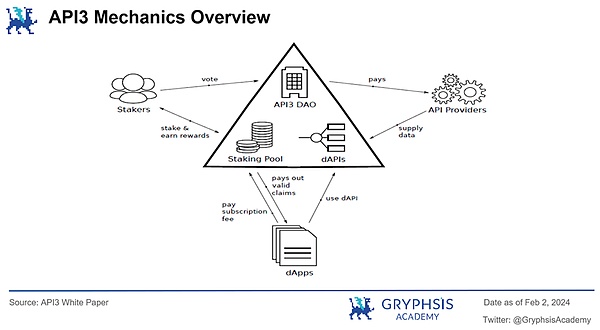
The overall mechanism of API3 is shown in the figure.Among them, API3 connects all parties as a platform in the form of decentralized autonomous organization (DAO).API providers earn benefits by providing data. DAPP can enjoy data services provided by DAPI through payment subscription fees. If DAPP users find that DAPI data is problematic, then claims can be submitted.The tokens will obtain the right to reward and API3 DAO through the pledge mechanism.The specific mechanism will be described in detail below.
>
In Web 2.0, API acts as a key bridge for data exchange between various digital platforms. As the key to digital interaction, software applications can seamlessly communicate and support the function of modern digital services in our lives.For example, when we use a ticketing website to book a ticket, the website usually rely on API to obtain real -time pricing and availability from the databases of various airlines.
The concept of DAPI has expanded the application mode of traditional API to decentralization.Unlike the traditional APIs that depend on centralized servers and third -party intermediaries, DAPI can provide users with direct data feed from data providers without any intermediary agency.
API3’s DAPI is based on the prediction machine that supports AirNode, allowing API providers to connect its data source directly to the blockchain network, so that DAPP can access the real world data in a security way without trust.
The API3 also provides two data interface services types: daPi and self -raised funds DAPI for developers, which meets different potential use cases.At the same time, API3 uses multiple signature wallets and governance agreements to manage the changes to its DAPI configuration, which balances flexibility and security.
Among them, the hosting DAPI aggregates the data of multiple first -party prophecy machines, and provides more reliable and stable data sources through the median function, which is suitable for those production environments that have high requirements for data quality and stability.In the mode of hosting DAPI, users need to pay the API3 to use the service, and the cost will be used to cover operation and management costs.
>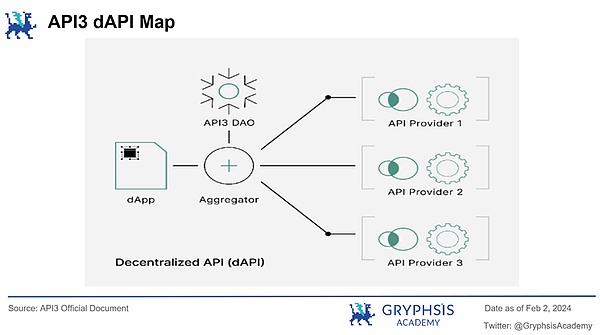
The specific mechanism is shown in the figure. Each API provider first sends the data to a single polymer to process and integrate data from different sources to ensure that DAPP receives reliable and consistent information.DAPP can obtain the processing data by calling DAPI and provides services based on these data.The API3 DAO supervises the entire process through voting and other governance mechanisms to ensure the transparency and security of the system.
On the other hand, the self -raised funds DAPI allows users to bear cost by themselves, providing data through a single first -party prophecy machine.This method can provide developers with more flexibility and autonomy, enabling them to test and use data interfaces with lower cost tests, especially suitable for early stages or applications that are more sensitive to cost.In this model, users need to provide funds for the operation of self -raised funds DAPI. These funds will be used to pay the transaction fee on the chain to ensure that the data is updated in a timely manner.
The innovation brought by the API3 in the DAPI mode may marker the paradigm change of the data consumption model in the decentralized environment in the future. This method not only directly reduces the delay of the delay, cost and potential faults related to third -party middlemen, which increases, which has increased, which has increased, which has enhanced the enhancement.The security and reliability of data represents an important step forward to seeking completely decentralized and efficient data solutions in Web3.0.
At the same time, the concept of DAPI has made API3 no longer only limited to the prediction machine feeding service, but provides a decentralized potential implementation and support for the ubiquitous API applications in our lives.
>
AIRNODE is the core key component of API3. This technology allows API providers to convert its API to DAPI and build a bridge between the direct communication between the API and the smart contract on the chain to achieve the real world data to the blockchain ecosystem.Stap flowing.
Specifically, AIRNODE is a server -free node. The key to its architecture is to emphasize decentralization and security.This node is easy to deploy and maintain the API provider, but also has high scalability.
Different from traditional prophecy machines that usually need complex settings and intermediary services, the design of AIRNODE allows API providers to become the first -party prophet without requiring third -party participation.Essence
>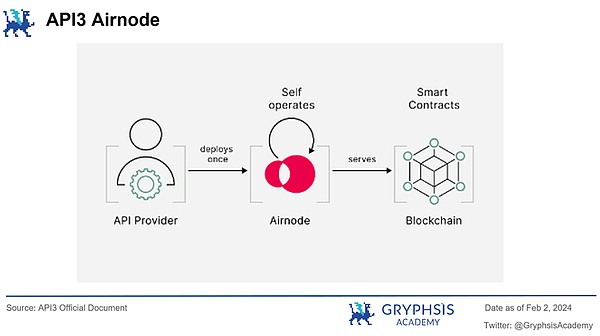
In addition, another major advantage of AIRNODE is its simplified API integrated process.This allows API providers to set and operate only the least blockchain knowledge and cost.This characteristic makes the process of API providers a simple process of prediction machine nodes, no friction, promoting the use of blockchain technology more democratic, and encouraging more widely data providers to participate in the centralized data market to enter the centralized data market.Essence
Therefore, essentially speaking, the design of AiRNODE is not limited to a prophet solution, but to build decentralized, secure and user -centric data ecosystem basic components.Through AIRNODE technology, API3 is expected to solve the common challenges facing traditional prediction machine services, such as transparency, trust and efficiency, and then pave the way for more powerful and reliable DAPP development.
>
In the field of cryptocurrencies, miners can extract value (MEV) have always been an important concept. Since the transaction on the chain is not completed in real time, block producers (such as miners or verifications) can be inserted, inserted, or replaced by transaction order, insertion, or replacementTrading and other methods to operate blocks and earn additional profits.The prediction machine can extract value (OEV) can be regarded as one of the subsets under MEV.
Recently, API3 announced the launch of the ZK-Rollup platform OEV Network. OEV Network is the ZK-Rollup network customized with Polygon CDK to capture OEV generated by all DAPPs using API 3 to reduce the value of the current DEFI operations.Discovery.At the same time, the adoption of rollup makes the entire process transparent and verified, making the entire process more decentralized and without trust, and enhances the confidence of user participation and use.
First of all, we can understand what OEV is through an example.Imagine that we are participating in a auction. Everyone’s bid is visible. The auctioneer can choose to consider the order of bid.This situation has created an opportunity for the auctioneer to benefit yourself or others through strategic bids, thereby earning additional income.
When the prediction machine is updated or the data is pushed to the blockchain, according to the time and method of the use of information, even small differences in time or information accuracy may create the opportunity to capture potential value for “suppliers”, such asRun, arbitrage, or liquidation.
The OEV network developed by API3 aims to make this process more systematic and democratic.OEV network runs as a special order stream auction platform. The value generated by the capture of the prophets during the data update process, and re -assigned the value to the DEFI protocol and its users.The process is performed by the auction, and those with the highest bid will win the right to update the data source, and the costs paid for this will be used to share with those DAPPs that use the API3 data source.
By capturing OEV, API3 introduced a novel source of income for DAPP, which strengthened the economic model of API providers and DAPP projects.Among them, the bidders need to pay an additional 10% fee on the basis of their bid, half of which are the source of income of API3, and the other half will be assigned to the prophet provider.It will also be able to motivate them to directly participate in the construction of the web3.0 ecology, thereby cultivating a more fair and transparent data ecosystem.At the same time, the mechanism of the auction feedback rights on the chain has also created a decentralized and secure environment, promoted a more fair data ownership model, and reduced the risks related to centralized data feedback.
It is worth mentioning that Polygon co -founder Sandeep NailWal praised the innovative solution of the value extraction of the API3 prophecy machine and called it an important breakthrough of the DEFI ecosystem.
总的来说,API3 的OEV 网络为dAPP 和预言机领域带来了重大进步,解决了关键的低效率问题,并为参与者释放了新的价值流,并有可能在未来为数据提供商和Users bring a more balanced and financially sustainable ecosystem.
>
According to the information provided by the White Paper, the source of income from API3 mainly includes the subscription fee paid by DAPP, and the prophecy machine can withdraw value (OEV) and the service guarantee fee.The use of agreement income includes but is not limited to supporting the continuous development of projects, increasing network security, operating costs, pledge rewards, and rewards for potential interests in the ecosystem.API3 controls the project through DAO and determines the distribution of its resources to ensure the sustainability and stable growth of the project.
>
>
According to Etherscan data, the current maximum total supply of $ API3 tokens is about 128 million, and the circulation supply is about 103 million.The cast tokens obtained by the unwavering part are the tokens. These tokens will not be unlocked only one year after the reward date.
>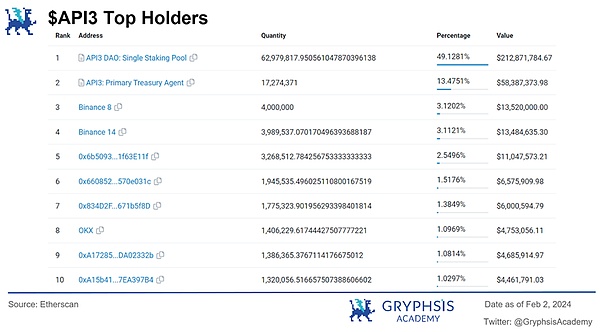
As shown in the figure, the maximum positioning address of the current $ API3 token is the pledge pool with $ API3. The second largest address is its national treasury.In addition, the exchanges like Binance and OKX are the main holders of $ API3.Therefore, the number of chips that really circulate in the market at $ API3 are not large, and the occurrence of severe pressure on a certain degree.
Overall, API3 has comprehensively adopted three aspects: pledge, mortgage and governance in its token economic model.The purpose is to motivate participation by ensuring that tokens can affect the trajectory of the project, effectively manage resources and participate in the expansion of the ecosystem, and protect the network and promote the growth of the project.By combining the three effects to build a good token system, the true decentralization of governance and operational activities is achieved.
>
The pledge mechanism is the most important core component of the API3 token economic model, which aims to combine the incentives of stakeholders with the long -term success of the project.By pledged $ API3 token, the holder can get the newly cast tokens (a week) as a pledge reward and get the right to vote for the API3 DAO.At the same time, the pledged tokens will also be used as mortgages. When DAPI fails, these tokens will be compensated as users.
>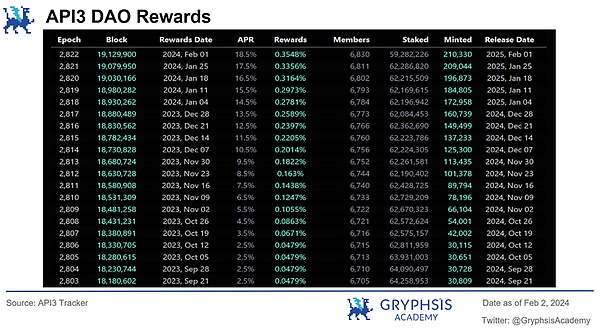
In order to ensure the continuity of the service, the quality of the product and the full decentralization of the governance, the API3 set a “pledge target” and always pursue the number of pledged tokens to reach a specific percentage of token.
At present, the pledge target of API3 is 64,097,566 tokens, and the current number of actual pledge has not yet reached the target.Therefore, as shown in the figure, the API3 DAO will increase by 1% of the next reward date to inspire more holders to pledge tokens, until the pledge target is reached or the APR is increased to 75%.
The tokens reward obtained by the pledker are cast, theoretically, this will lead to token inflation.Therefore, in order to make a balance, the API3 design a currency tightening mechanism to solve the problem.First of all, as shown in the figure above, the cast tokens will not be unlocked after one year on the reward date.This method encourages participants to hold and pledge tokens for a long time instead of short -term speculation.
>
Secondly, the API3 DAO will require users of DAPI to burn or lock the $ API3 token at a specific time to obtain data services.As shown in the figure above, by checking the open source code of the API3, we find that it allows any address to decide whether to enable or disable its own combustion permissions by itself, and burn a certain amount of tokens by calling the Burn function.
This method offsets the inflation brought by the new casting tokens to a certain extent, effectively reduced the market supply pressure of the $ API3, benefited all tokens holders, and also enhanced the long -term investors and participants.Pure confidence.
>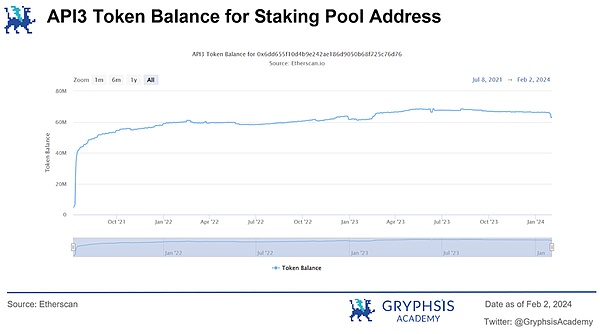
By viewing the pledge of $ API3 in the past, we also found that since 2021, the number of token pledge has been in a very stable state and has not experienced violent fluctuations.And even when the price of $ API3 has risen sharply in the near future, the number of pledge in its pledge remains stable as a whole, and there is no large -selling selling phenomenon. The side proves the effectiveness of the API3 pledge mechanism.
>
API3’s mortgage mechanism can be considered as a prediction machine service insurance product on the chain, which is achieved by providing quantitative security, and this security is reflected in the form of service guarantee.
The entire process can be summarized to the following key steps:
>
In essence, this process is similar to buying a insurance, but it does not require any traditional insurance policy.Once the agreement confirms that the function of DAPI fails, the user will get compensation from the pledge pool.At the same time, API3 also supports a variety of cryptocurrency types (such as ETH), which shows the diversification of its services and mortgage mechanisms.
More importantly, API3’s mortgage model design and bring a negative feedback loop self -adjustment mechanism to avoid the system’s own excessive expansion and potential self -destructive behavior.Specifically, when the API3 DAO expansion and increase the new DAPI users, its excessive load causes the risk of DAPI to fail and trigger compensation.
Therefore, the potential compensation demand provides the motivation for the API3 DAO to provide the motive not to increase the load during the governance process to ensure that the API3 will not bear unnecessary risks due to short -term interests.This method helps to encourage and promote the stable growth and sustainability of the responsible responsibility of the API3 DAO.
In this way, the incentives of DAPI users and other token pledges have become consistent, because they all have the common goal of avoiding the system failure.The pledges are motivated to supervise and maintain the healthy operation of DAPI due to possible insurance compensation, while users benefit from the stability and reliability of this system.
In addition, the claimer of the service guarantee must pledge the tokens to make claims, which increases the cost of claiming claims, thereby reducing the probability of false or abuse claims.This mechanism prevents the system from being abused by those who may use the guarantee mechanism for personal interests rather than system health.
In the end, the adjustment mechanism of negative feedback cycles will help to inhibit the violent fluctuations of the value of the token.In the token economy, stability is the key to attract long -term investors and users.By inhibiting excessive risk and failure, this cycle helps to establish confidence in the $ API3 token as a long -term value storage.
>
In the API3 DAO, the only way to obtain the right to vote is to pledge the $ API3 token.Therefore, the governance party assumes all the risks and returns of the API3.As mentioned earlier, if the governors do not actively participate and cause a large number of claims, they will bear the loss, and the tokens they pledge will re -flow into the market and be purchased by the new governor.
On the contrary, if the governance is proper, the supply of $ API3 tokens in the market will also be reduced accordingly. It may bring to the increase in tokens due to scarcity, so that the governors can get more benefits.This method enables the API3 DAO to continuously improve itself and recover from failure, realizing true decentralization.
>
In general, API3’s token economic model is a carefully designed complex model.The $ API3 tokens have been given pledge, acting as mortgages, insurance pools, governance voting rights, and obtaining DAPI services and other uses and needs.The inflation problem reduced the pressure.
More importantly, its economic model will deeply combine the operation and risk of the $ API3 token and the project itself, as well as the value (supply volume) of the tokens. In this caseIt is the most important tool for participants to implement incentives. The maximum inspiration to inspires tokens must actively participate in governance to reduce their risk of suffering.
In this way, the long -term development of the project itself is very closely related to the stakeholders’ related stakeholders, which not only ensures the long -term stable development of the project, but also greatly promotes the realization process of truly decentralization.
>
In recent years, the prophet track has experienced significant growth and development with its unique technical capabilities and extensive application scenarios. According to the data of Coingecko, the total market value of the prophecy machine track has currently exceeded $ 13 billion.As an indispensable component of blockchain technology, it is predicted that the bridge is connected to the information gap between the encrypted world and the real world, which provides a way to obtain external data for smart contracts.
>
For a long time, ChainLink is the absolute leader of the prophet track. According to DEFILLAMA data, ChainLink can now provide services to more than 50 different networks and 360 protocols. TVS (Total Value Secured) has exceeded 17 billion yuanThe US dollar, its market value is much higher than other competitors.
However, this market structure does not mean that there is no challenge and competitors.For example, the positioning of API3 is the first -party prophecy machine solution, emphasizing the direct data feed from data providers to blockchain, which aims to reduce the dependence and potential failure points related to third -party prophecy machines such as ChainLink.Provides greater advantages in accuracy and delay.
>
In August 2020, ChainLink’s nine node operators were attacked.Because ChainLink’s node is to obtain and verify the data of the real world through the request of the smart contract, and then pass the data to the smart contract method to operate, this process needs to consume the GAS fees on Ethereum to pay these operations.
The attacker launch an attack by sending a large amount of seemingly effective price feeding requests to the Chainlink node, resulting in the sudden facing the huge Ethereum GAS cost of the Ethereum, and then the $ CHI developed by 1INCH as a GAS token at that time to hedge the gAS hedge GASPrice fluctuations.After the casting, the attacker sold these tokens to $ ETH, which effectively squeezed the $ ETH in the node wallet, which eventually caused about 700 $ ETH losses.
Although after the incident, Chainlink took timely remedial measures and continued to improve its agreement to improve network security and reliability.However, considering the significance of the ecology on the chain, the risks related to the prophecy machine will be used as an important consideration that we cannot ignore. For example, Mango Markets and Bonq Dao are alsoMajor losses.
In fact, the attacker used the mechanism of the third -party prophecy machine for these attacks.In contrast, the first part of the prophet brings different solutions.
>
>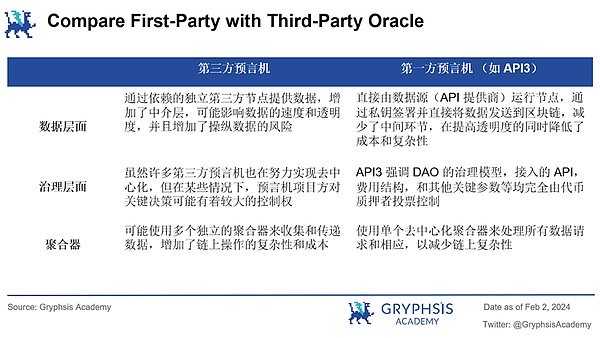
The traditional third -party prophecy machine is a node of the predictor of the prediction machine by a third -party middleman. The intermediary agencies need to converge external data and enter the smart contract.This mechanism has led to data consumers not only to trust data providers, but also to trust intermediaries, introduce additional trust layers and potential costs, and may cause potential potentialWorries.
For example, in order to inspire third -party nodes to provide reliable services, third -party prophecy machines usually require the middle business cost (Middleman Tax) to motivate honest behavior, and this additional cost is not existing in the first -party prophet model.In addition, from a certain level, the mechanism of a third -party prophecy machine may be considered not to be truly decentralized.
In contrast,As the first -party prophecy machine, the API3 allows API providers to operate the prediction machine node by themselves, while improving the reliability and integrity of the data, it provides better decentralization and cost -effectiveness in a safer way.Way.
>
When it comes to the first party prophecy machine, the Pyth Network protocol that has to be mentioned is the recently popular Pyth Network protocol.Next, we will analyze API3 and Pyth Network.
>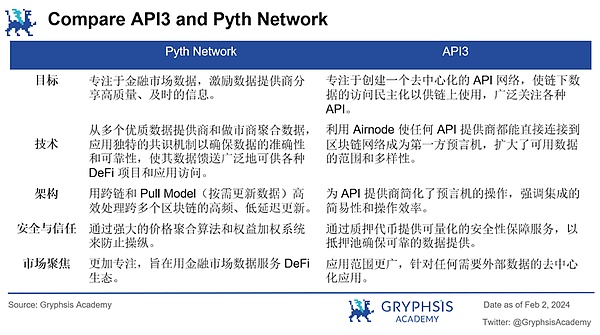
It is not difficult to see that both projects have made important contributions to the web3.0 ecosystem by solving the key needs of reliable and decentralized data sources.The main advantages of API3 include:A wider range of data application scope, completely decentralized DAO governance model, low operation difficulty, cost benefits, high transparency, and stronger token economic models.
>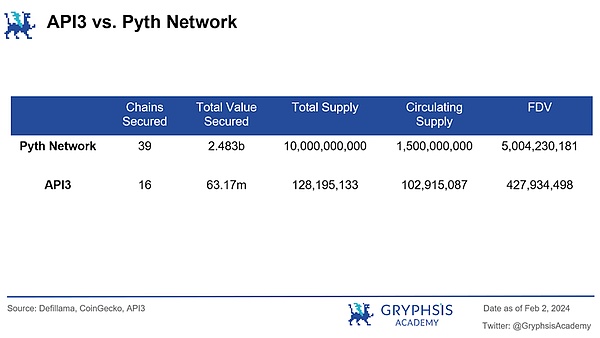
From these data, we can see that Pyth Network has greater advantages in the current integration depth and coverage.However, this does not mean that the API3 lacks competitiveness. At present, less integrated agreement gives API3 the opportunity to focus on providing high -quality services and deeply cultivate on the blockchain it serves.In the future, with the continuous development of blockchain technology and the increase in application scenarios, API3 can expand its market share by increasing integrated links, protocol support, and increased its value guarantee.
In addition, the current smaller market size of API3 may make it more flexible, can quickly adapt to market changes and user needs, and bring more room for growth and expansion.In the future, we look forward to continuously improving its position in the industry through innovation and optimization.
Therefore, we still have a reason to be optimistic about the development prospects of API3, combined with the OEV Network introduced in the previous article,When DAPI’s architecture is combined with OEV Network and ZK-Rollup, and it is governed by completely decentralized DAO, we can see that the future of API3 may not just provide prophet services as an intermediate component, but there is a service machine service, but there is anyIt may become an infrastructure for the development of ecology and DAPP projects on the chain, and even has the potential to subvert the market currently led by the third -party prophecy machine.
>
Although API3 has brought strong expectations for our advantages, any blockchain project is facing a series of unique risks, and the main risks of API3 may include the following points:
Admission rate:The future success of API3 depends to a large extent on the adoption of API providers and its integration with blockchain projects.If the API3 fails to obtain sufficient appeal or the adoption rate does not meet the expectations, this may have a negative impact on the success of the project and the value of its token.
Provider loss:If a large number of API providers stop their services or choose not to adopt API3, this may limit the diversity and quality of available data, which may affect the effectiveness of the API3 network.
Security vulnerability:Like any blockchain project, API3 may also be affected by the potential security vulnerabilities of its protocols, smart contracts or AIRNODE technology itself.Any security vulnerability or vulnerability can cause the loss of funds or data and weaken the user’s trust in the platform.
Competitive pattern:The competition in the prediction machine is very fierce, and old -fashioned players like Chainlink already have a considerable market share.The concept and design of API3 are very creative, but this does not guarantee the long -term success of the project. Therefore, API3 still needs to stand out and prove its value to overcome the pressure of competition.
Therefore, in addition to its innovative methods and mechanisms, the success of API3 will also depend on many factors such as technology execution, market adoption, competition differentiation, and regulatory environment.Like all investment in the cryptocurrency field, we should thoroughly understand the advantages and risks involved in the project itself before making investment decisions.
>
In general, API 3 brings us a pioneering method in the field of prediction machines. Through the first part of the prophecy machine and DAPI, the data provider and the blockchain network directly connect to enhance security, transparency, transparency, transparency, transparencyAnd efficiency, while reducing costs related to data tampering related to data tampering.
In addition, API 3 has a well -designed and powerful token economic model. Through DAO’s governance model, the smart contract platform can use DAPI to build meaningful DAPPs in a way that is truly decentralized and trustworthy.
Combining the launch of its OEV Network, we have reason to expect that API 3 will be adopted by more blockchain networks and DAPP protocols in the future, and has the opportunity to become an infrastructure for ecological development on the chain to promote decentralized applicationsDevelopment and innovation.
Reference information
[1] https://tracker.api3.org/
[2] https://etherscan.io/token/0x0b38210EA11411557C13457DC6EA731B88A
[3] https://docs.api3.org/explore/
[4] https://www.theblock.co/post/76986/chainLink-ttack-Eth
[5] https://www.wublock123.com/index.php?m=ContenT& ;c=index& ;a=show en ;cAMP ;id=47 en ;id=23865
statement
This report is an original work completed under the guidance of @GryphsisISACADEMY @0xmarkyzl, under the guidance of mentor @cryptoscott_eth.The author is responsible for all the content. This content does not necessarily reflect the view of Gryphsis Academy, nor does it necessarily reflect the view of the organization who entrusted the report.Edit content and decision -making are not affected by readers.Please know that the author may have cryptocurrencies mentioned in this report.This document is for information reference only, and should not be used as a basis for investment decisions.It is strongly recommended that you conduct your own research and consult the neutral financial, tax or legal consultant before investing in investment decisions.Remember that the past performance of any asset does not guarantee future returns.








